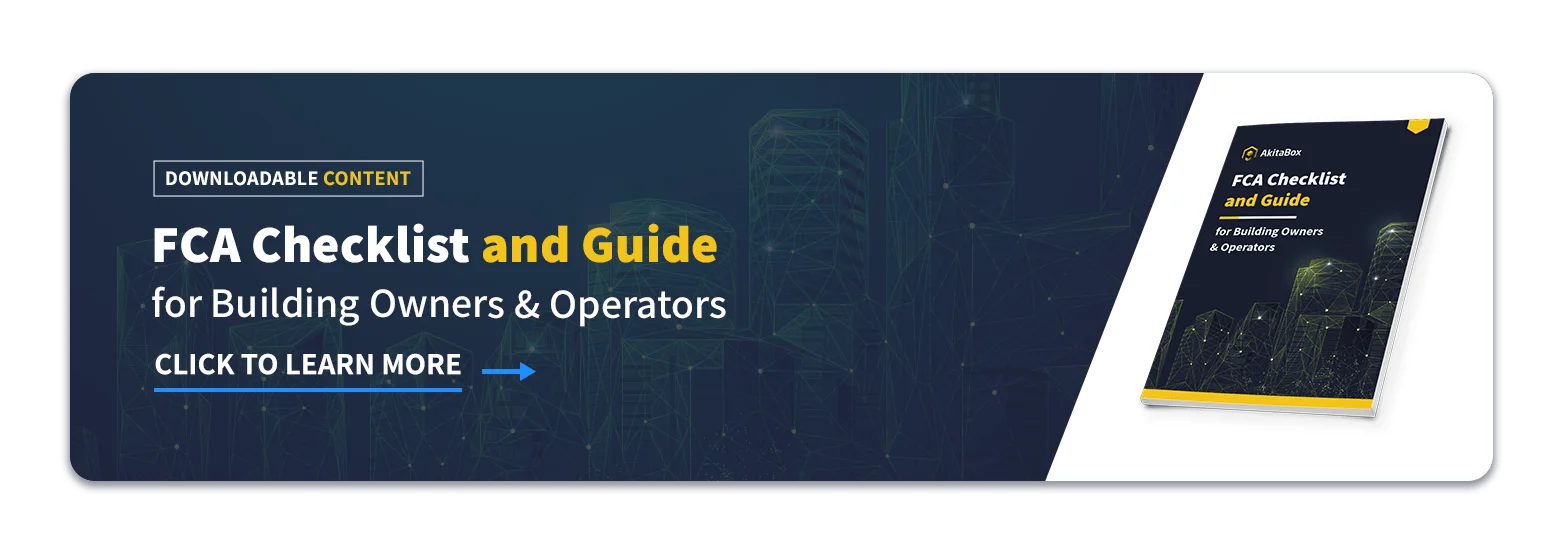Your typical Facility Condition Assessment (FCA) results are like a bunch of grapes in a vineyard, freshly plucked from the vine. As soon as those grapes come off the vine, they start to die. It doesn’t look like it right away, of course. But your grapes won’t stay fresh forever.
The data in your traditional FCA – including the cost estimates and asset conditions – begins to erode almost as soon as the report reaches your hands. That’s because, as a static report, it’s not designed to be continuously updated. It’s cut off from the constant stream of facilities data that could keep it alive. As a result, your FCA results start becoming obsolete almost immediately – and stop providing value to your organization in just 6 months to a year.
Why is this happening? Why aren’t organizations maintaining their original FCA data so they always have fresh information for decision making?
Casey Morris (National FCA Leader at McKinstry) and Josh Lowe (Chief Solutions Officer and Co-Founder at AkitaBox) tackled those questions in a recent webinar: How to Get More from Your FCA Data.
There are a number of factors, as seen in the chart below. Whether it’s limited time, limited resources, or limited expertise, many organizations don’t have the bandwidth to conduct their own FCA. And if you don’t have the resources to do an FCA, you don’t have the resources to maintain it either.
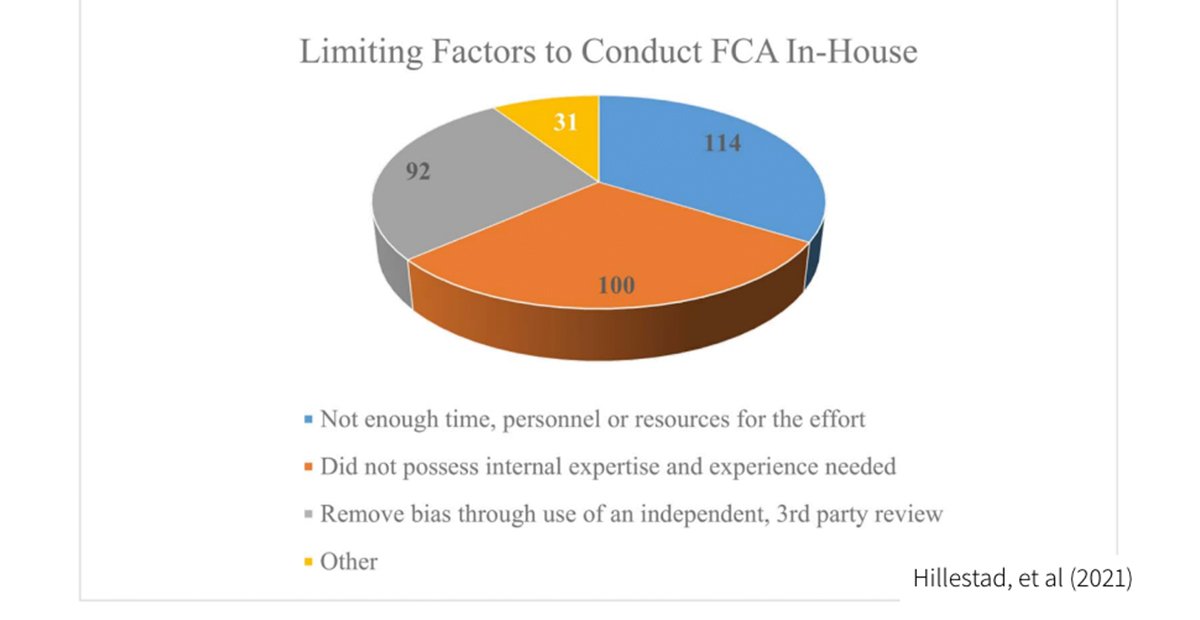
Because many companies struggle to maintain their data, they end up stuck on the hamster wheel of cyclical FCAs. You outsource your FCA to a firm, helplessly watch it become obsolete, and then do it all over again in 3-7 years.
In addition, since each FCA is conducted independently, inconsistencies often result. Every FCA firm does their assessments somewhat differently. So if you hire ABC firm one year and then XYZ firm in five years, you’re going to get different data sets.
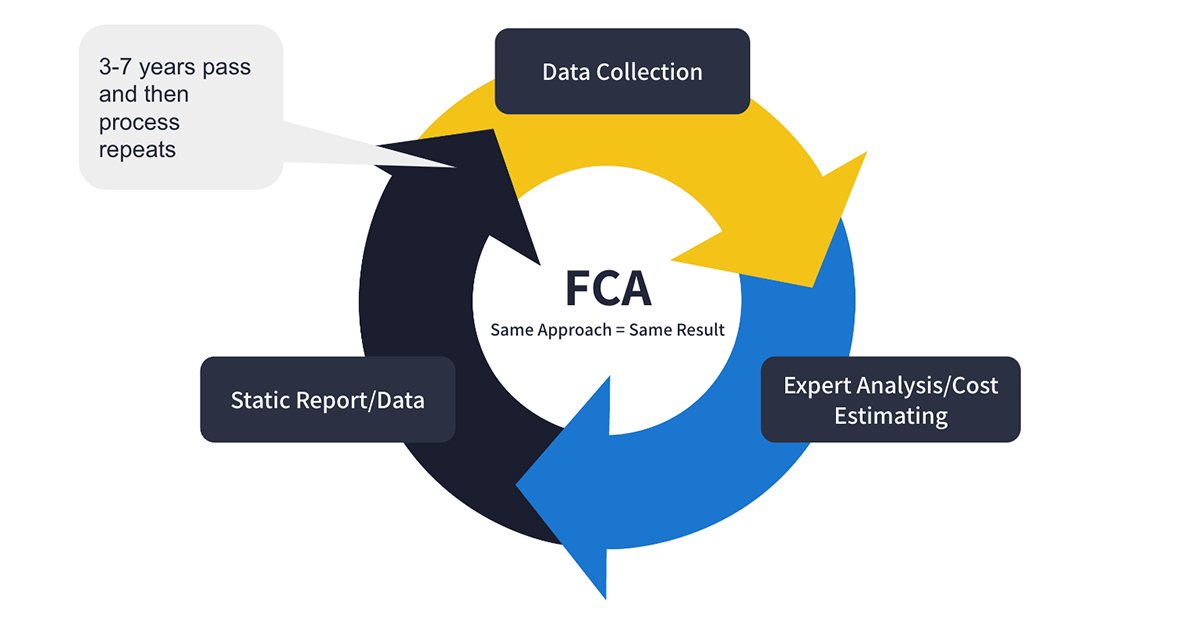
To sum it up, a cyclical or recurring FCA has a few shortcomings:
One-time-use: It’s created based on data collected at one specific time. Meanwhile, the facility itself keeps evolving. Once the facility changes, the FCA becomes obsolete.
Wasteful: Hours, days, weeks of work go into building an FCA that’s only helpful in the short-term. Then it collects dust and is eventually tossed out and completely redone in a few years.
Not additive: Once the FCA is done, there’s no easy way to keep it updated and add new information to it.
No comparative analysis: It’s a snapshot followed by another snapshot in 5 years. Plus, each FCA might be completed by a different firm. That makes it very challenging to understand how a facility’s data has changed over time.
Of course no one wants that. But what’s the solution?
Data That Never Dies: the Living FCA
Imagine an FCA that never expires. Data that’s up-to-the-minute accurate. An assessment that only needs to be refreshed every 10 years. Whatever you call it – a living FCA, continuous FCA, or maintained FCA – it’s real, and it’s possible.
Software makes it possible – in particular, software that connects your FCA data with the rest of your facilities data in one system. With all of your data in one platform, your data is interconnected – your maintenance history can feed into your FCA data, your FCA data can inform your preventive maintenance planning, and on and on.
AkitaBox Pulse is an example of this type of software platform. It’s a complete facilities management system that you can use to manage your FCAs, maintenance, assets, inspections, and capital planning.
A Cost Comparison: Cyclical vs. Continuous FCAs
The charts below are courtesy of Casey Morris at McKinstry. They illustrate the costs of cyclical FCAs versus a maintained FCA – using real numbers from a former client of Casey’s.
Over 15 years, this client would spend more than a million dollars for every FCA on their 12 million square feet. Every five years, they’d start over with a new FCA – spending another million dollars each time.
They were stuck in a cycle they couldn’t escape. Over 15 years, they spent more than $4 million to do recurring FCAs. The real kicker? That total cost included $45,000/year for the FCA software license they used. They were paying for it, but doing nothing with it.
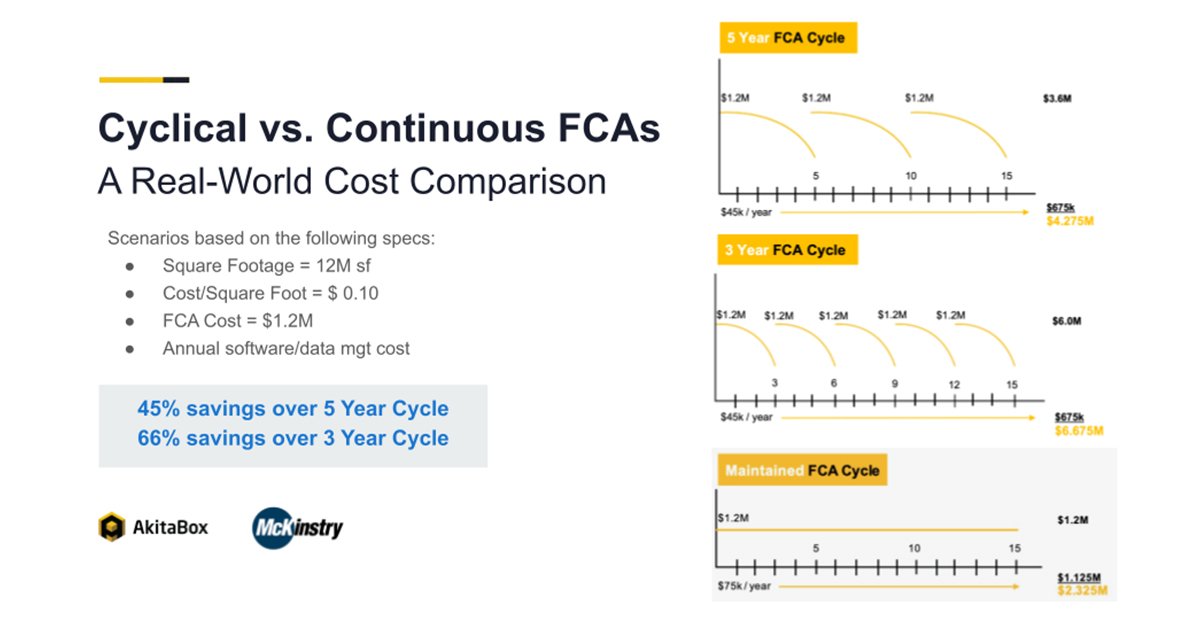
Could the solution be to conduct FCAs more frequently? Say, every 3 years? Doing so keeps the data fresher and more valuable. But you’re still spending that million dollars every 3 years to do a new FCA. Putting boots on the ground to touch the building’s square footage is the most expensive piece of a facility condition assessment. So in fact, doing FCAs more often is even more expensive – to the tune of more than $6 million dollars over 15 years.
The bottom chart shows what it would cost Casey’s client to maintain their FCA data. Beginning with a fresh FCA, the organization could keep their data up-to-date and spend a smaller sum for regular refreshes from their FCA firm. The total price tag in this scenario ($2.3 million over 15 years) includes software licensing plus consulting costs for regular check-ins with the software vendor to ensure everything is running smoothly.
For a fifth of the cost of a traditional FCA, you can keep that data alive for years. The numbers make a compelling case for a living FCA over a recurring one.
3 Tips for Transitioning to a Living FCA
Ok. You get it. Cyclical FCAs leave a lot to be desired. Of course having a living FCA would be better. But how do you get there? Start with these 3 steps.
Whip Your Data into Shape with Facilities Management Software
Even the best facilities people in the world struggle to maintain building and asset data without the proper tools.
Basic spreadsheets and databases are no longer the right means for managing sophisticated facilities information. If you want to keep your data alive, it needs an environment designed to help it flourish – a facilities management technology platform. Here are 3 benefits of implementing an FM system.
1. Data interoperability & a single source of truth
So much of today’s facilities data comes from multiple sources and lives in various silos. It’s hard to find, hard to track, and haphazardly updated. In an ideal world, all of your data is working together. Your FCA data feeds into your preventive maintenance plan. Your work orders feed into your FCA. Your inspections feed into work orders. And so on.
An FCA can start to pull some of that knowledge together and build that repository where everything’s communicating with everything else. A facilities management software platform serves as a single spot where all of that data comes together for easier access and analysis.
2. The basis for a digital twin
Implementing facilities management software that’s location-based is the first step in building your own digital twin. This type of platform maps your assets on your floor plan in a digital environment where it’s a snap to interact with your data and keep adding more information over time.
A digital twin makes it easier to know where all your assets are, what you’re maintaining and tracking within your building, and where any piece of data you need is located.
3. Easier data stewardship
The expense of collecting data is the biggest burden in an assessment. But not if you’re equipping the right people at the right time with the right tools.
Imagine a maintenance tech walking up to an asset armed with a tablet containing your facilities management software. All they have to do is scan that asset’s QR code and up pops all the most up-to-date information they need.
A lot of times, the right person – who happens to be in the right place at the right time to notice a concerning hum from a piece of equipment – doesn’t have a way to pass that information back to the people who need to know about it.
Whether it’s an outside engineer or an in-house team member, everyone with boots on the ground at your facility needs to be able to update your data in real time when they notice an issue. Not only can they immediately update the condition of that humming asset, they can note that it needs to become a higher priority based on this new information.
This isn’t some utopian fantasy. Technology exists today that makes this possible. Everyone in the field can be empowered to update facilities data, keeping it alive and sustainable.
Now you have a steady stream of fresh information coming in from the field. You’re no longer making decisions based on five-year-old data, but on real-time insights.
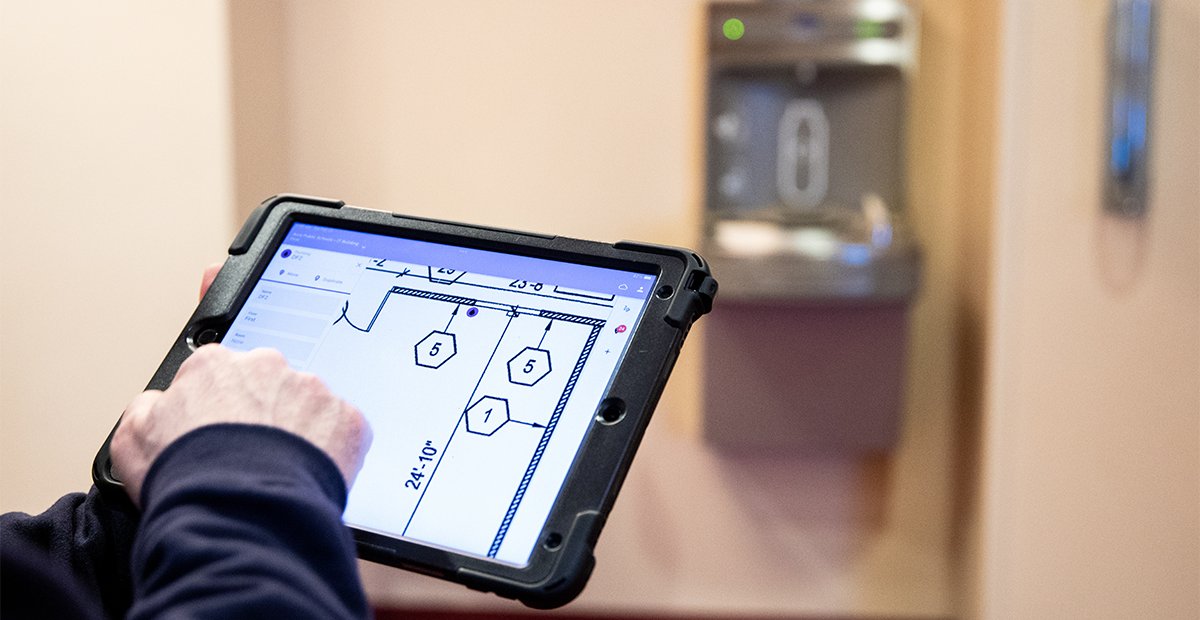
Ask For It in Your RFP
Every FCA provider conducts their assessments a little differently, with different timeframes and different people walking the buildings. If you don’t lay out clear expectations in your RFP, you’ll end up with whatever data the firm chooses to give you – and it might not be everything you want.
In your RFP, clearly spell out to potential FCA firms that you want continuously maintained FCA data. Request that the firm help you put together a workflow for keeping the data alive over time. This workflow will be your roadmap for what happens during and after the initial assessment – and it should answer questions such:
- What data needs to be collected in the FCA?
- Who will be responsible for maintaining the data?
- What technology/tools/processes will be used to do it?
- How often will the FCA be refreshed?
Make Maintaining FCA Data a Joint Effort
An FCA provider can do more than simply collect data in the initial assessment. They can:
- Update asset condition data anytime they’re onsite
- Provide current cost estimating
- Help you analyze and make decisions based on the constantly revised data coming in from the field
Maintaining an FCA is a big job. Many building owners are seeing the value in keeping FCA consultants on board to shoulder some of the burden.
Ready to Resurrect Your Data?
Finding the right partners is key to your success in moving to a continuous FCA. You need an FCA firm you can build a long-term relationship with. And you need a facilities management software partner that can assist you in keeping your data organized and accessible.
AkitaBox can help you with both. Let us introduce you to our assessment firm partners who use our innovative FCA software. AkitaBox FCA software feeds directly into our comprehensive facilities management platform, so all of your building data lives in one easy-to-use tool.
Visit our Facility Condition Assessment Resource Center to get started.
